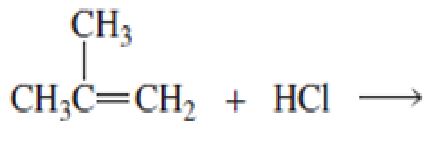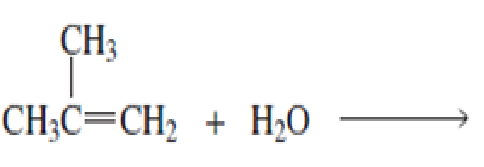
Essential Organic Chemistry (3rd Edition)
3rd Edition
ISBN: 9780321937711
Author: Paula Yurkanis Bruice
Publisher: PEARSON
expand_more
expand_more
format_list_bulleted
Concept explainers
Textbook Question
Chapter 6.5, Problem 11P
- a. What is the major product of each of the following reactions?




b. What do the first three reactions have in common?
c. How do the first three reactions differ?
Expert Solution & Answer
Want to see the full answer?
Check out a sample textbook solution
Students have asked these similar questions
3. Which is the major product of this reaction?
b.
C.
OH
d.
а.
H2/Pd
Substitution and Elimination (Please draw the structures involved in the reactions)
A. Which will react more rapidly via SN1? 1-bromo-2,2-dimethylpropane or 2-bromo-2-
methylbutane? Explain.
B. Which will react faster via SN2? 1-chlorocyclohexane or 1-chloro-1-methylcyclohexane?
Explain.
Which reaction can be used to carry out the following transformation?
A.
B. 1.
AICI 3
AIC13
2. HCI, Zn(Hg)
C. Either is okay
D. Neither will work
Chapter 6 Solutions
Essential Organic Chemistry (3rd Edition)
Ch. 6.1 - Draw the mechanism for the reaction of cyclohexene...Ch. 6.2 - a. How many bond orbitals are available for...Ch. 6.2 - Prob. 3PCh. 6.2 - Prob. 4PCh. 6.3 - Prob. 5PCh. 6.3 - Prob. 6PCh. 6.3 - Prob. 7PCh. 6.5 - Prob. 9PCh. 6.5 - Prob. 10PCh. 6.5 - a. What is the major product of each of the...
Ch. 6.5 - Prob. 12PCh. 6.6 - What stereoisomers are obtained from each of the...Ch. 6.6 - Prob. 14PCh. 6.8 - Prob. 15PCh. 6.10 - Name the following:Ch. 6.10 - Draw the structure for each of the following: a....Ch. 6.10 - Draw the structures for and name the seven alkynes...Ch. 6.10 - Name the following:Ch. 6.10 - Name the following:Ch. 6.11 - What hybrid orbitals are used to form the...Ch. 6.13 - Prob. 22PCh. 6.14 - Prob. 23PCh. 6.14 - Which alkyne would be the best one to use for the...Ch. 6.14 - Prob. 25PCh. 6.14 - Prob. 26PCh. 6.15 - Describe the alkyne you would start with and the...Ch. 6.15 - What are products of the following reactions?Ch. 6 - Prob. 29PCh. 6 - Prob. 30PCh. 6 - Prob. 31PCh. 6 - Prob. 32PCh. 6 - What is each compounds systematic name?Ch. 6 - Prob. 34PCh. 6 - Prob. 35PCh. 6 - What reagents could be used to carry out the...Ch. 6 - Prob. 37PCh. 6 - Prob. 38PCh. 6 - Prob. 39PCh. 6 - Prob. 40PCh. 6 - Prob. 41PCh. 6 - Prob. 42PCh. 6 - Answer Problem 42 using 2-butyne as the starting...Ch. 6 - What is each compounds systematic name?Ch. 6 - Prob. 45PCh. 6 - Prob. 46PCh. 6 - Prob. 47PCh. 6 - Prob. 48PCh. 6 - Prob. 49PCh. 6 - Prob. 50PCh. 6 - Draw the keto tautomer for each of the following:Ch. 6 - Propose a mechanism for the following reaction...Ch. 6 - Prob. 53PCh. 6 - Prob. 54PCh. 6 - Prob. 55PCh. 6 - Propose a mechanism for the following reaction:Ch. 6 - Prob. 57PCh. 6 - Prob. 58PCh. 6 - Prob. 59PCh. 6 - Prob. 60PCh. 6 - Prob. 61PCh. 6 - Prob. 62P
Knowledge Booster
Learn more about
Need a deep-dive on the concept behind this application? Look no further. Learn more about this topic, chemistry and related others by exploring similar questions and additional content below.Similar questions
- 1. What would be the major product of the given reaction? 2. What would be the major product of the given reaction? 1) .AICI, 1) , AICI3 2) mCPBA 2) CH3CH2MgBr, ether 3) H30* OH А. A. ou OH В. В. С. OH D. D.arrow_forwardFor the following reaction scheme, match the correct reagent to each reaction (A, B, C, D and E).arrow_forwardDraw the products of each reaction.arrow_forward
- Draw the products of each reaction. Assume excess halogen is present.arrow_forward7. In eight steps or less, convert the given starting materials into the desired products. eight steps or less a. b. Br CI eight steps or less HO, OHarrow_forwardWhat alkenes are formed from each alkyl halide by an E2 reaction? Label the major and minor products Hint: Remember Zaitsev's rule! a. Br b. Br C.arrow_forward
- What are the major products of the following reactions? Include stereochemistry. a. 1. Hg(OAc)₂, CH₂OH 2. NaBH4, H₂O, EtOH b. 1. Hg (OAc)₂, (CH3)₂CHOH 2. NaB H₁, H₂O, EtOHarrow_forwardThese reagents can produce ketones with alkynes A. BH3, THF, H2O2 B. KMnO4 C. O3 D. H2SO4, H2O, HgSO4 choices:A,DB,CA,B,CA,B,C,Darrow_forwardDraw the products formed in each Wittig reaction. Draw the major stereoisomer when applicable.arrow_forward
- These reagents can produce ketones with alkynes A. BH3, THF, H2O2 B. KMnO4 C. O3 D. H2SO4, H2O, HgSO4arrow_forwardDraw the products of each reaction. CHO Br. OCH3 Br2 so3 a. -CN i. H2SO, FeBr3 H2SO4 CH3 NaSCH,CH3 CH,COCI j. AICI3 HNO. b. f. -NHCOCH, -F H2SO, "NO2 CH3O но NO2 CH3 NO2 So3 H2SO, HNO3 H2SO, C. HO. NO2 CH;CH,CI AICI Cl2 d. C- -ососн h. CH;0- -COOCH3 FeClaarrow_forwardWhat is the major product of the following reaction? A. B. NO₂ NO₂ NO₂ CH3CI, AICI3 C. D. NO₂ NO₂arrow_forward
arrow_back_ios
SEE MORE QUESTIONS
arrow_forward_ios
Recommended textbooks for you
 Organic Chemistry: A Guided InquiryChemistryISBN:9780618974122Author:Andrei StraumanisPublisher:Cengage Learning
Organic Chemistry: A Guided InquiryChemistryISBN:9780618974122Author:Andrei StraumanisPublisher:Cengage Learning

Organic Chemistry: A Guided Inquiry
Chemistry
ISBN:9780618974122
Author:Andrei Straumanis
Publisher:Cengage Learning
Alcohols, Ethers, and Epoxides: Crash Course Organic Chemistry #24; Author: Crash Course;https://www.youtube.com/watch?v=j04zMFwDeDU;License: Standard YouTube License, CC-BY